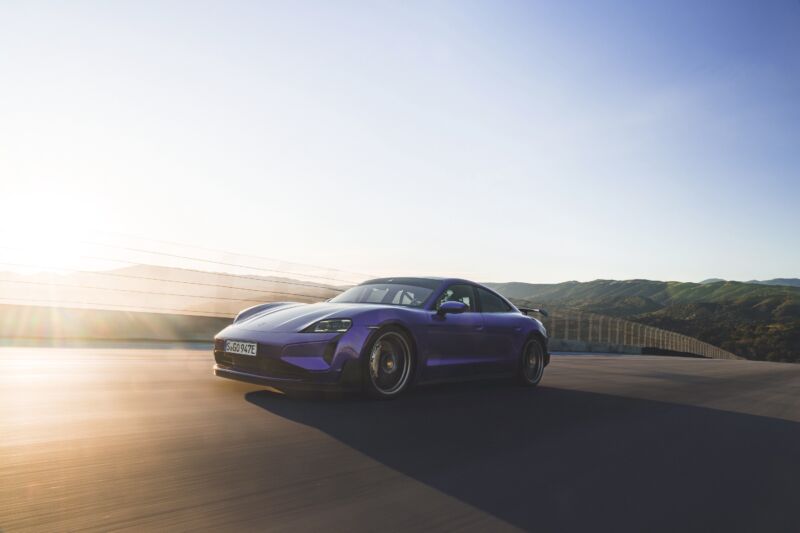The new EV has set lap records at Laguna Seca and the Nürburgring.

Porsche is adding another new variant to its highly competent Taycan electric sedan. As part of the electric Porsche’s midlife refresh, there’s a new Taycan that sits atop the performance tree, appropriately named the Taycan Turbo GT. It’s the most powerful Taycan you can buy, with a peak output of 1,092 hp (815 kW), and the boffins in Germany have even cut about 157 lbs (72 kg) from the curb weight.
The eagle-eyed Porsche observer probably knew a faster Taycan was on the way. In January, wearing manufacturer’s camo and described as an “unnamed pre-production prototype,” the Taycan Turbo GT lapped the Nürburgring Nordschleife in 7:05.55, 20 seconds faster than Tesla’s best time with its Model S Plaid (and 26 seconds faster than the Taycan Turbo S, previously the fastest variant).
Now, shorn of its camouflage and proudly bearing the Turbo GT name—as well as sporting the Taycan’s new facelifted look—it has set a new record at Laguna Seca in California. With development driver Lars Kern behind the wheel, the Taycan Turbo GT lapped the 2.2-mile (3.6 km) circuit in 1:27.87, which is a track record for a production EV at that track.
Power output is 777 hp (580 kW) in normal operation, but engage launch control, and that overboosts to 1,019 hp (760 Nm), with peak power of 1,092 hp for a couple of seconds. And Porsche’s Formula E program has had some influence here: While driving, you can engage “attack mode,” which boosts power by an additional 160 hp (120 kW) for 10-second bursts. Porsche has set up attack mode so it can be engaged or deactivated by a paddle on the steering wheel for ease of use while on track.Advertisement
Among the changes under the skin are a new rear drive unit, common to the facelifted Taycans. But for the Turbo GT there’s a new silicon carbide pulse inverter that’s capable of up to 900 V, rather than the 600 V inverter in the Taycan Turbo S. The two-speed transmission has also been upgraded to cope with the Turbo GT’s peak torque of 988 lb-ft (1,340 Nm).
- The purple car with the big rear wing is the Turbo GT with the Weissach package. Porsche
- Lars Kern set laps in a pair of Taycan Turbo GTs—the purple car and this black one. Porsche
- The Taycan Turbo GT negotiates the corkscrew. Porsche
- The “purple sky metallic” paint is one of two new colors for the Turbo GT for this year. Porsche
- The Turbo GT interior. Porsche
- A rather happy-looking Lars Kern next to his record-setting rides. Porsche

You’ll need to specify the Turbo GT with the Weissach package—named for Porsche’s R&D base near Stuttgart—if you want to save weight as well as add power. This uses carbon fiber to replace heavier trim pieces, thinner glass, and a lighter sound system and ditches the automatic closing of the rear trunk, plus one of the two charge ports and even the rear speakers in order to save the aforementioned 157 lbs.
The Weissach package also cuts the 0-60 mph time from 2.2 seconds down to 2.1 seconds and allows for a 190 mph (306 km/h) top speed instead of topping out at 180 mph (290 km/h).
“The track at Laguna Seca pushes the Taycan Turbo GT to the limit. It’s the overall package that makes the difference,” said Kern. “The Turbo GT with Weissach package sets new standards in almost every metric. These include acceleration and braking, an “Attack Mode” that’s intuitive to use, and a powertrain designed for maximum traction and performance. And the cornering grip levels are just as impressive. The controllability and light-footedness are unbelievable. The tires work very well, and you have the right balance in every driving situation. It is incredibly good fun to drive this car around the undulating track at Laguna Seca.”
None of this comes cheap, however. The 2025 Taycan Turbo GT will start at $230,000 when it arrives in showrooms this summer.




